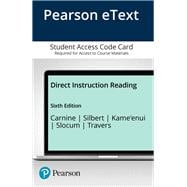Direct Instruction Reading gives you detailed guidance in teaching any child who struggles with reading in the alphabetic writing system. Unique in its approach of leaving little to chance or guesswork, the text thoroughly addresses the what, when, why and how of successful literacy instruction.
For courses in Reading in Special Education or Direct Instruction Reading (K-6)
Pearson eText is an easy-to-use digital textbook that you can purchase on your own or instructors can assign for their course. The mobile app lets you keep on learning, no matter where your day takes you -- even offline. You can also add highlights, bookmarks, and notes in your Pearson eText to study how you like.
NOTE: This ISBN is for the Pearson eText access card. Pearson eText is a fully digital delivery of Pearson content. Before purchasing, check that you have the correct ISBN. To register for and use Pearson eText, you may also need a course invite link, which your instructor will provide. Follow the instructions provided on the access card to learn more.










